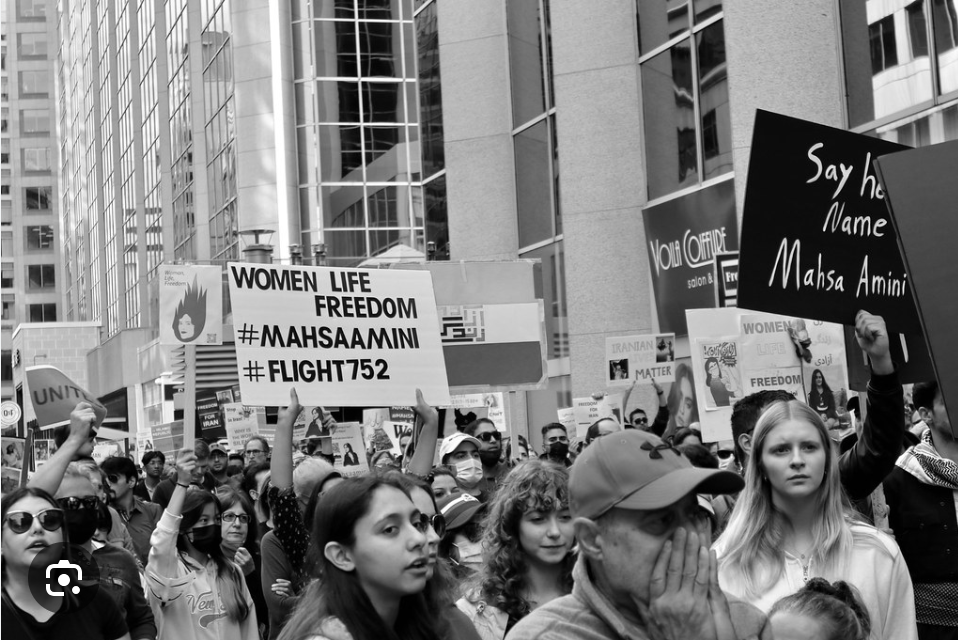Sarah Soroosh Moghadam / Opinion / 8 October 2023
Worldwide protests against compulsory hijab are bringing attention to women’s rights issues in Iran.

Image Credit: Iran Protests, Taymaz Valley, Sept. 25, 2022, Flickr, (https://www.flickr.com/photos/taymazvalley/52382844957). CC BY 2.0.
Human rights in Iran have been criticized by countless organizations and activists since the Iranian Revolution in 1979. Women's rights are at the forefront of these issues, recently brought to light by worldwide protests against compulsory hijab.
Since the Islamic Republic was brought into power through the Iranian Revolution, continuous bans have been instituted to control the lifestyle of women. Most prevalently, all women and girls, beginning at the age of nine, are required to wear a head covering. Other bans include watching men’s sports, leaving the country without a husband's permission and dancing in public. All these laws are mandated by the government’s morality police, who take unabiding women into custody.
Though some enforcement of laws has grown laxer over the years, morality police continue to threaten the safety of Iranian women. Many women taken into custody are faced with rape, sexual assault and abuse.
Narges Mohammadi, the spokeswoman for the Defenders of Human Rights Center, was arrested in 2019 for advocating against these laws and has since spoken extensively about the harassment she faced in prison. “I felt like a sheep who was thrown into the car,” she said. “They [target] prisoners based on their gender.”
However, due to censorship, this form of activism is categorized as propaganda and defamation and results in harsh consequences. Mohammadi now faces a sentence of 30 months in prison and 80 lashes because of her advocacy.
Mohammadi is not the only woman who has suffered at the hands of the morality police. Countless other prisoners have come forward with stories of various forms of sexual harassment and psychological abuse. Recently, some women’s experiences have made international headlines.
On Sept. 16, 2022, 22-year-old Mahsa Amini was arrested for allegedly not wearing a hijab in accordance with government standards. Once in custody, she was severely beaten and died in a hospital due to police brutality.
Following Amini's death, protests began in Iran for more freedoms or possibly an overthrow of the state. Many focus on women's rights, including burning headscarves and chanting "women, life, freedom" as a form of protest. School girls, men and teenage boys have also shown their support for women.
Yet women in Iran have been advocating for change for years.
In 2006, a campaign called One Million Signatures for the Repeal of Discriminatory Laws was founded. The campaign called for equal rights in marriage and inheritance and stricter punishments for honor killings, among other human rights violations. Though it faced major setbacks after government intervention and police brutality, its efforts received international recognition. The prominent journalists and activists who founded the movement received monumental awards including the Global Women's Rights award.
Another form of activism was through the Zanan magazine, the only Persian women’s magazine in the country. Launched in 1922, it covered the concerns of many Iranian women while aiming to protect and promote their rights. Articles often discussed controversial issues, such as reform politics and domestic abuse. Due to backlash, the magazine was shut down in 2008 and later relaunched, until publication of the magazine was suspended by the government in 2015. Zanan received recognition from the international press and sparked a conversation about women’s rights that continues to this day.
The recent women’s rights protests have, in many ways, been met with similar enforcement by the Iranian government. Thousands of people, including protesters, journalists, lawyers, athletes and artists have been arrested due to their activism, and many met the same fate as Amini. Since her death, over 500 people have been killed by police brutality.
Nonetheless, women’s rights activists continue to gain international attention as calls for gender equality in Iran resume growing. Several influential organizations, including Human Rights Watch, the Center for Human Rights in Iran, Humanists International and the United Nations have condemned the government's actions and demanded the repeal of compulsory veiling.
The current unrest in Iran is, arguably, greater than ever. According to a poll by the Group for Analyzing and Measuring Attitudes in Iran, three-quarters of Iranians opposed mandatory hijab, of which 84 percent would prefer a secular state to a theocracy. Though the fight for women’s rights in Iran has gone on for years, often with little tangible success, the women of Iran remain undeterred. Opposition to these human rights violations may be never ending — the fight will last as long as necessary for equality to be achieved.
Comments